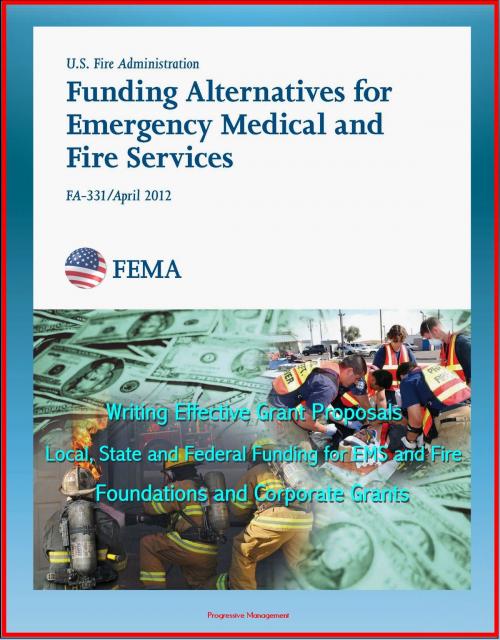2012 Funding Alternatives for Emergency Medical and Fire Services: Writing Effective Grant Proposals, Local, State and Federal Funding for EMS and Fire, Foundations and Corporate Grants
Nonfiction, Health & Well Being, Medical, Allied Health Services, Emergency Medical Services, Social & Cultural Studies, Social Science| Author: | Progressive Management | ISBN: | 9781476401676 |
| Publisher: | Progressive Management | Publication: | August 15, 2012 |
| Imprint: | Smashwords Edition | Language: | English |
| Author: | Progressive Management |
| ISBN: | 9781476401676 |
| Publisher: | Progressive Management |
| Publication: | August 15, 2012 |
| Imprint: | Smashwords Edition |
| Language: | English |
The purpose of this manual is to identify the various grants and innovative funding alternatives available for emergency medical services (EMS) and fire protection services. Where appropriate, a discussion of the pros and cons of a particular funding source is discussed. In some instances, examples are given to illustrate how alternative funding is being successfully implemented in EMS agencies and fire departments across the country.
This report is divided into several major sections identifying various sources of available funding and revenue options. Striking the right balance between different sources of local revenue has become an essential skill for EMS and fire administrators and chief officers. So, too, has the ability to identify and acquire grants and other alternative revenues. To meet this critical need and serve its constituents regarding effective methods for obtaining funding, USFA developed the publication, Funding Alternatives for Fire and Emergency Services.
EMS agencies and fire departments require funding for expenses such as equipment, training, and salaries in order to provide necessary protection to their respective communities. However, with tighter budgets, less government subsidies, and fewer donations, it is becoming increasingly more difficult for EMS agencies and fire departments to meet greater and more complex demands for its services. However, there have been many recent changes in the availability of Federal funding for EMS agencies and fire departments, including the Firefighter Investment and Response Enhancement (FIRE) Act, the Staffing for Adequate Fire and Emergency Response (SAFER) Act grant program(s), as well as other important gran programs. This updated document includes sources of Federal funding as well as other new and innovative funding sources not discussed in previous editions.
Chapter 1: Introduction * Chapter 2: About This Manual * Local Revenue and Funding Alternatives * State and Federal Funding Programs * Private-Sector Sources * Writing an Effective Grant Proposal * Implications of Funding Choices * Scope * Sources of Information * Summary * Chapter 3: Writing an Effective Grant Proposal * Grant Fundamentals * Basic Components of a Proposal * Where to Get Help * Interaction and Networking * Books on How to Write a Grant Proposal * Help for Nonprofit Organizations * Where to Find Help on the Internet * Chapter 4: Local Revenue and Funding Alternatives * Sources of Local Revenue * Development Impact and User Fees * Fines, Forfeitures, and Penalties * Enterprise Funds and Utility Rates * Sale of Assets and Services * Benefit-Assessment Districts * Borrowing * Entrepreneurial Emergency Medical Services * Cost-Saving Strategies * Nontraditional Fundraising Ideas * Chapter 5: State Funding for Emergency Medical Services * State Sources of Revenue * State-Managed Federal Grants * Specific State Grants and Aid Programs * Alabama * Alaska * Arizona * Arkansas * California * Colorado * Connecticut * Florida * Georgia * Hawaii * Idaho * Illinois * Indiana * Iowa * Kansas * Kentucky * Maine * Maryland * Montana * New Mexico * North Carolina * North Dakota * Ohio * Oklahoma * Oregon * Pennsylvania * Tennessee * Texas * Utah * Virginia * Washington * Wisconsin * Wyoming * Chapter 6: Federal Funding for Emergency Medical Services and Fire Agencies * Federal-Funding Basics * Types of Federal Grants * Data Universal Numbering System Number * Federal Grants * Chapter 7: Foundations and Corporate Grants * Foundations * Common Types of Foundation Grants * Corporate-Giving * Program-Related Investments * Philanthropy and Private Grants * Appendix A: Successful Grant Application Example * Appendix B: State Emergency Medical Services Offices * Appendix C: State Fire Marshal Offices * Appendix D: State Homeland Security Contacts * Appendix E: State Emergency Management Agencies * Appendix F: Success Stories
The purpose of this manual is to identify the various grants and innovative funding alternatives available for emergency medical services (EMS) and fire protection services. Where appropriate, a discussion of the pros and cons of a particular funding source is discussed. In some instances, examples are given to illustrate how alternative funding is being successfully implemented in EMS agencies and fire departments across the country.
This report is divided into several major sections identifying various sources of available funding and revenue options. Striking the right balance between different sources of local revenue has become an essential skill for EMS and fire administrators and chief officers. So, too, has the ability to identify and acquire grants and other alternative revenues. To meet this critical need and serve its constituents regarding effective methods for obtaining funding, USFA developed the publication, Funding Alternatives for Fire and Emergency Services.
EMS agencies and fire departments require funding for expenses such as equipment, training, and salaries in order to provide necessary protection to their respective communities. However, with tighter budgets, less government subsidies, and fewer donations, it is becoming increasingly more difficult for EMS agencies and fire departments to meet greater and more complex demands for its services. However, there have been many recent changes in the availability of Federal funding for EMS agencies and fire departments, including the Firefighter Investment and Response Enhancement (FIRE) Act, the Staffing for Adequate Fire and Emergency Response (SAFER) Act grant program(s), as well as other important gran programs. This updated document includes sources of Federal funding as well as other new and innovative funding sources not discussed in previous editions.
Chapter 1: Introduction * Chapter 2: About This Manual * Local Revenue and Funding Alternatives * State and Federal Funding Programs * Private-Sector Sources * Writing an Effective Grant Proposal * Implications of Funding Choices * Scope * Sources of Information * Summary * Chapter 3: Writing an Effective Grant Proposal * Grant Fundamentals * Basic Components of a Proposal * Where to Get Help * Interaction and Networking * Books on How to Write a Grant Proposal * Help for Nonprofit Organizations * Where to Find Help on the Internet * Chapter 4: Local Revenue and Funding Alternatives * Sources of Local Revenue * Development Impact and User Fees * Fines, Forfeitures, and Penalties * Enterprise Funds and Utility Rates * Sale of Assets and Services * Benefit-Assessment Districts * Borrowing * Entrepreneurial Emergency Medical Services * Cost-Saving Strategies * Nontraditional Fundraising Ideas * Chapter 5: State Funding for Emergency Medical Services * State Sources of Revenue * State-Managed Federal Grants * Specific State Grants and Aid Programs * Alabama * Alaska * Arizona * Arkansas * California * Colorado * Connecticut * Florida * Georgia * Hawaii * Idaho * Illinois * Indiana * Iowa * Kansas * Kentucky * Maine * Maryland * Montana * New Mexico * North Carolina * North Dakota * Ohio * Oklahoma * Oregon * Pennsylvania * Tennessee * Texas * Utah * Virginia * Washington * Wisconsin * Wyoming * Chapter 6: Federal Funding for Emergency Medical Services and Fire Agencies * Federal-Funding Basics * Types of Federal Grants * Data Universal Numbering System Number * Federal Grants * Chapter 7: Foundations and Corporate Grants * Foundations * Common Types of Foundation Grants * Corporate-Giving * Program-Related Investments * Philanthropy and Private Grants * Appendix A: Successful Grant Application Example * Appendix B: State Emergency Medical Services Offices * Appendix C: State Fire Marshal Offices * Appendix D: State Homeland Security Contacts * Appendix E: State Emergency Management Agencies * Appendix F: Success Stories















